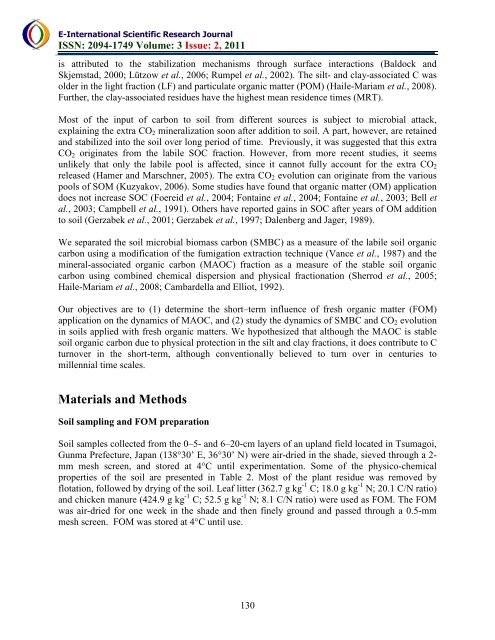download the full article here - E-International Scientific Research ...
download the full article here - E-International Scientific Research ...
download the full article here - E-International Scientific Research ...
You also want an ePaper? Increase the reach of your titles
YUMPU automatically turns print PDFs into web optimized ePapers that Google loves.
E-<strong>International</strong> <strong>Scientific</strong> <strong>Research</strong> Journal<br />
ISSN: 2094-1749 Volume: 3 Issue: 2, 2011<br />
is attributed to <strong>the</strong> stabilization mechanisms through surface interactions (Baldock and<br />
Skjemstad, 2000; Lützow et al., 2006; Rumpel et al., 2002). The silt- and clay-associated C was<br />
older in <strong>the</strong> light fraction (LF) and particulate organic matter (POM) (Haile-Mariam et al., 2008).<br />
Fur<strong>the</strong>r, <strong>the</strong> clay-associated residues have <strong>the</strong> highest mean residence times (MRT).<br />
Most of <strong>the</strong> input of carbon to soil from different sources is subject to microbial attack,<br />
explaining <strong>the</strong> extra CO 2 mineralization soon after addition to soil. A part, however, are retained<br />
and stabilized into <strong>the</strong> soil over long period of time. Previously, it was suggested that this extra<br />
CO 2 originates from <strong>the</strong> labile SOC fraction. However, from more recent studies, it seems<br />
unlikely that only <strong>the</strong> labile pool is affected, since it cannot <strong>full</strong>y account for <strong>the</strong> extra CO 2<br />
released (Hamer and Marschner, 2005). The extra CO 2 evolution can originate from <strong>the</strong> various<br />
pools of SOM (Kuzyakov, 2006). Some studies have found that organic matter (OM) application<br />
does not increase SOC (Foereid et al., 2004; Fontaine et al., 2004; Fontaine et al., 2003; Bell et<br />
al., 2003; Campbell et al., 1991). O<strong>the</strong>rs have reported gains in SOC after years of OM addition<br />
to soil (Gerzabek et al., 2001; Gerzabek et al., 1997; Dalenberg and Jager, 1989).<br />
We separated <strong>the</strong> soil microbial biomass carbon (SMBC) as a measure of <strong>the</strong> labile soil organic<br />
carbon using a modification of <strong>the</strong> fumigation extraction technique (Vance et al., 1987) and <strong>the</strong><br />
mineral-associated organic carbon (MAOC) fraction as a measure of <strong>the</strong> stable soil organic<br />
carbon using combined chemical dispersion and physical fractionation (Sherrod et al., 2005;<br />
Haile-Mariam et al., 2008; Cambardella and Elliot, 1992).<br />
Our objectives are to (1) determine <strong>the</strong> short–term influence of fresh organic matter (FOM)<br />
application on <strong>the</strong> dynamics of MAOC, and (2) study <strong>the</strong> dynamics of SMBC and CO 2 evolution<br />
in soils applied with fresh organic matters. We hypo<strong>the</strong>sized that although <strong>the</strong> MAOC is stable<br />
soil organic carbon due to physical protection in <strong>the</strong> silt and clay fractions, it does contribute to C<br />
turnover in <strong>the</strong> short-term, although conventionally believed to turn over in centuries to<br />
millennial time scales.<br />
Materials and Methods<br />
Soil sampling and FOM preparation<br />
Soil samples collected from <strong>the</strong> 0–5- and 6–20-cm layers of an upland field located in Tsumagoi,<br />
Gunma Prefecture, Japan (138°30’ E, 36°30’ N) were air-dried in <strong>the</strong> shade, sieved through a 2-<br />
mm mesh screen, and stored at 4°C until experimentation. Some of <strong>the</strong> physico-chemical<br />
properties of <strong>the</strong> soil are presented in Table 2. Most of <strong>the</strong> plant residue was removed by<br />
flotation, followed by drying of <strong>the</strong> soil. Leaf litter (362.7 g kg -1 C; 18.0 g kg -1 N; 20.1 C/N ratio)<br />
and chicken manure (424.9 g kg -1 C; 52.5 g kg -1 N; 8.1 C/N ratio) were used as FOM. The FOM<br />
was air-dried for one week in <strong>the</strong> shade and <strong>the</strong>n finely ground and passed through a 0.5-mm<br />
mesh screen. FOM was stored at 4°C until use.<br />
130

















